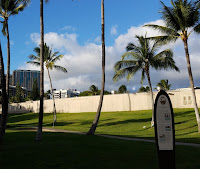“The island of Oahu offered the best natural port in the Hawaiian Islands and once the US Navy committed to establishing a major base there, the Army was assigned and enthusiastically undertook the mission to defend this against all known threats” (4).
The Book
When most people hear “Pearl Harbor” their immediate reaction is to think of the Japanese attack on Pearl Harbor in 1941, which caught the US Army and Navy by surprise. What people don’t realize is the amount of thought and work that went into fortifying the island of Oahu from a naval and amphibious landing attack, not an attack from the air. Defenses of Pearl Harbor and Oahu 1907-50 introduces the reader to that fortification process.
Initial defense plans were developed in 1901, taking advantage of Oahu’s natural features and focusing on coastal and land attacks. From 1907 to 1938, the Army spent $150 million on defenses. Batteries (gun emplacements) were built at strategic locations along the coast; eventually there would be fifteen. They were typically two stories of reinforced concrete, with large guns on the upper level and smaller guns on the lower level. In addition, both the Army and Navy built airfields and anti-aircraft defenses. After the surprise attack on December 7, 1941, underground facilities were built and naval turrets were adapted for coastal defense. Post-World War II, many of the defense sites were adapted for different uses by the Army and Navy. Most still exist today because they were built to withstand an attack and are too difficult to destroy.
Authors McGovern and Williford do a good job of describing the design and construction of the various defense mechanisms around Oahu. For the most part, the information is easy to follow and doesn’t get too technical. However, this book is definitely more for a niche audience: those interested in military history and defense. The photos and illustrations throughout the book have very clear and detailed captions. There are a handful of computer illustrations that provide a detailed look when a photo isn’t available or descriptive enough. I appreciated these, but sometimes found the captions hard to read (they were often black text on a dark background).
The Place
The US Army Museum of Hawaii is located in Battery Randolph, one of the batteries built to help defend Oahu. Visitors learn about a variety of topics related to the defense of the Hawaiian Islands. I really enjoyed the museum because of this variety. The building itself is unique, made out of reinforced concrete with no windows. Interspersed throughout exhibits are mannequins staged to operate the battery against attackers. Exhibits about Hawaiian warriors defending their island precedes exhibits on the work of the US Army to build up the island’s defense. The impact of World War II on the military, civilian population, and Japanese Americans is explored. Finally, visitors learn about the role Hawaii played during the Vietnam War.If this is the type of museum you enjoy, I would recommend planning plenty of time. We stopped in, after another tour, and ended up rushing through the last parts. While it doesn’t appear to be a big museum, there is a lot of information packed in. The museum is open Tuesday-Saturday from 10am-5pm and admission is free. It is a part of Fort DeRussy and located in the heart of Waikiki. In fact, the famous beach is just on the other side of the battery.










